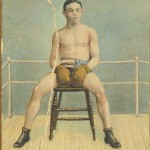Floyd Mayweather, Charlie Goldman and a Ring Education

We are, in a sense, in between bouts at the moment and I find myself thinking about Charlie Goldman and the rantings of Floyd Mayweather, Jr. Best known as Rocky Marciano’s trainer, Goldman fought as a bantamweight and pushed his mashed nose into more than 400 fights back around the early 1900’s.
Sporting a derby hat and always good for a quote, when asked about women and marriage, Goldman replied that he preferred to live “a la carte.”
In a picture which graced a trading card from the Mecca Cigarette Company, 1910, Goldman looks small and tired as he rests, legs splayed, on the stool in his corner—which is propped on what appears to be a wooden plank floor. It is not surprising that he looks tired, roughly 22 years old in the card, by his own account Goldman began to box professionally at the age of nine. A citizen of Brooklyn, he fought Terrible Terry McGovern’s brother in a series of three round smokers orchestrated by Sam Harris—George M. Cohan’s partner in the theatre. Of the fights, Goldman is quoted by the great A.J. Liebling as saying: “We learned a lot that way… they always had a bet going so you had to take it serious.”
Liebling goes on to give a bit more of Goldman’s chronology: “By the time he was fourteen he was traveling around the country, arranging his own fights and collecting his purses whenever possible.”
With what were said to be brittle hands (who can know, 400 fights!), Goldman never won a championship himself. He did, however, train five.
When asked about the problem of a lack of “artistic competence” in boxing, many during Marciano’s reign blamed TV, which had killed the farm system of the neighborhood fight clubs. Goldman, however, told Liebling that
“It is compulsory education,” he says. “You take a kid who has to stay in school until he is sixteen, he is under a disadvantage. All the things he should have learned to do when he was young he has to start at the beginning. How to move his feet, slip a punch, throw a hook—like finger exercises on the piano. A fighter shouldn’t have to think about those things, he should think about how to use them. A kid learns them before he begins to think about girls, they are the most important things in the world to him. Sixteen is too old, especially the way kids are today.”
Norman Mailer, speaking of the great boxers of his era, wrote of a kind of non-intellectual or kinesthetic intelligence—a brilliance of the body—a knowing of the nerves. Mailer also suggested that intellectual learning could impede that bodily brilliance— books and words essentially getting in the way of synaptic cognizance.
Or perhaps it’s just a zero sum game: time doing homework is not time in the ring, and vice versa.
Either way, Floyd Mayweather, Jr. has been boxing since he was 7. And it is, perhaps, safe to say that his recent comments about Manny Pacquiao prove that outside the ring, he simply was not the victim of a compulsory education.